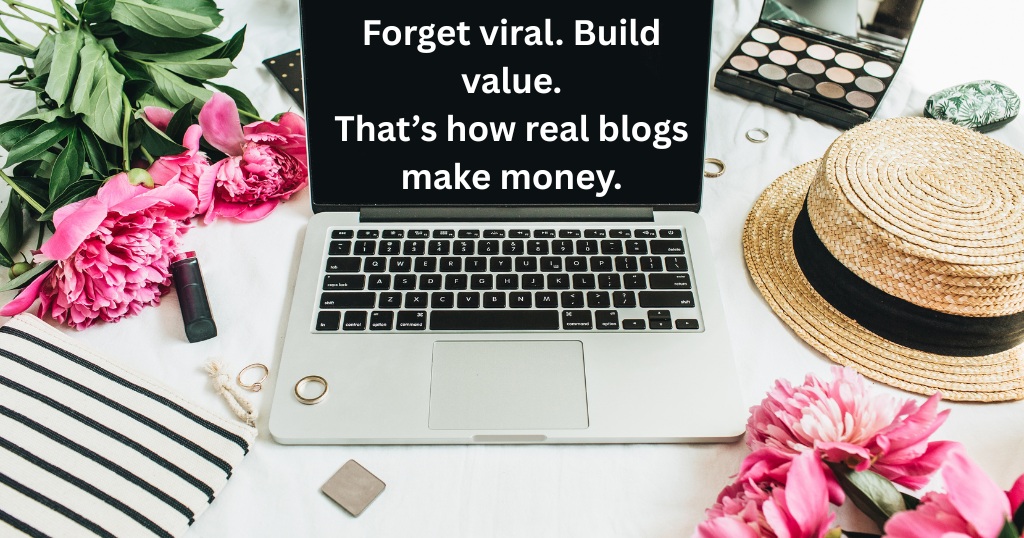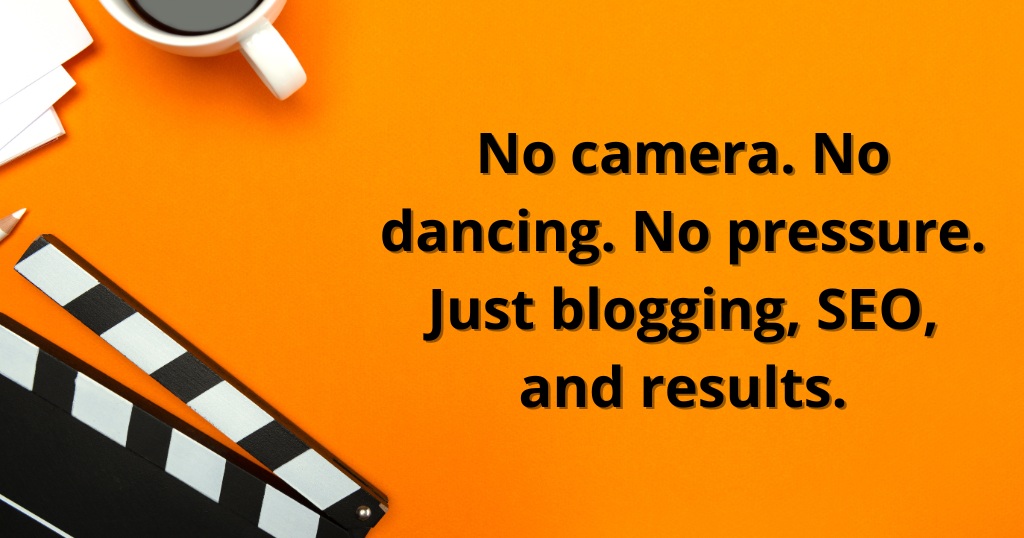I Started With Just a Blog… and a $9 Domain
It was a chilly fall morning in Portland, Oregon, and I remember sitting in a cozy corner of my apartment, laptop open, coffee in hand — wondering if I’d ever figure out this “make money online” thing. YouTube was full of overnight success stories. TikTok was buzzing with side hustles. But everything felt chaotic and unrealistic.

Until I heard someone say:
“Affiliate blogs earn while you sleep.”
That sentence hit different.
As a side hustler with no social following, no YouTube channel, and zero experience, blogging felt like the only strategy I could actually control. One domain, one hosting plan, and one well-written post — that was all I needed to start.
Now, after writing hundreds of posts (many of which still earn traffic and commissions months later), I can confidently say:
👉 Blogging + SEO is still one of the most powerful ways to build passive affiliate income.
And today, I’m going to show you exactly how to do it — even if you’re starting from scratch, and even if you’ve failed before.
All you need is consistency, free tools like Pinclick, beginner-friendly hosting like Hostinger, and a step-by-step strategy.
If you’re wondering how to start an affiliate marketing blog that actually earns money, this guide breaks it down step by step. You’ll learn how to choose a domain, set up your blog with beginner tools like Hostinger, write helpful content with SEO, and promote it using Pinterest. No tech skills or audience required — just simple, honest blogging that turns clicks into commissions.
What Is an Affiliate Marketing Blog (And Why It Still Works in 2025)
If you’ve ever clicked a blog post titled “Best Travel Backpacks for Women” or “Top 10 Side Hustles to Start From Home,” chances are — you landed on an affiliate marketing blog.

These aren’t just casual diaries or opinion pieces. They’re digital storefronts designed to answer questions, recommend products, and earn commissions when someone clicks a link and makes a purchase.
Here’s how it works:
- You write blog posts that target search terms people are Googling.
- You include helpful advice + product recommendations.
- When readers click your affiliate links and buy — you earn a commission.
Simple? Yes. Easy? Not always — but very doable.
🧠 Why This Still Works in 2025
Some people think blogs are “dead” because of TikTok and YouTube. But here’s the truth:
- Google gets over 8.5 billion searches a day — and many of those lead to blog posts.
- Blogs offer evergreen visibility — one post can drive traffic for years.
- You can grow without being on camera, dancing, or posting 10 times a day.
Affiliate blogs also give you full control. You’re not tied to an algorithm. You’re building a digital asset that works for you 24/7 — especially when you understand SEO (which we’ll get into next).
And the best part?
Most beginners start with just one blog post, one product, and one niche — and scale from there.
Why SEO Is the Secret Weapon Behind Profitable Affiliate Blogs
When I published my first blog post, I thought it was pretty good — catchy title, personal story, a few affiliate links. But nothing happened. No clicks. No sales. Just silence.
It wasn’t until I learned the basics of SEO (Search Engine Optimization) that things started to change.
Suddenly, my posts were getting found on Google. My Pinterest pins were ranking. And one blog that once felt invisible started bringing in daily traffic — and daily commissions.
🧠 What Exactly Is SEO?
If you’re new to this, don’t worry — here’s the simplest definition:
SEO means writing blog posts that show up when people search for something on Google or Pinterest.
You do this by:
- Using the right keywords (tools like Pinclick help with this)
- Structuring your blog post clearly (headlines, lists, good formatting)
- Offering genuine value instead of just salesy fluff
💡 Why SEO Works So Well for Affiliate Blogs
- It’s free: Unlike ads, SEO traffic doesn’t cost money.
- It builds over time: One blog post can rank for months or even years.
- It brings buyer intent: People searching “best air purifiers for allergies” aren’t browsing — they’re ready to buy.
SEO lets you tap into this intent — naturally, passively, and with no “influencer” status required.
In fact, most successful affiliate bloggers aren’t famous at all. They’re just smart about how they write and who they write for.
And that’s exactly what you’ll learn in the next section — step by step.
How to Build Your First Affiliate Blog From Scratch (Even If You’re Not Techy)
I remember thinking, “Is starting a blog going to be super technical?”
Turns out — it wasn’t. In fact, I built my first affiliate blog in one weekend, from my couch, with a $9 domain and $2.99/month hosting.

Here’s how to get started without getting stuck:
✅ Step 1: Get Hosting + Your Domain Name
Your blog needs a “home” on the internet. That’s where hosting comes in.
👉 I personally recommend Hostinger for beginners — it’s super affordable, fast, and comes with free email + domain name.
Pick a domain that’s:
- Easy to remember (e.g. giftguidegal.com)
- Niche-relevant (e.g. kitchenhacksdaily.com)
- Brandable (no hyphens or numbers)
✅ Step 2: Install WordPress (One Click)
Once you’ve signed up with Hostinger, you can install WordPress in one click.
No coding. No tech headaches. Just follow the prompts, and boom — your site is live.
✅ Step 3: Pick a Clean, Mobile-Friendly Theme
Start simple. I used a free theme like Kadence or Astra at first — fast-loading and easy to customize.
Make sure it:
- Looks clean on mobile
- Has space for a blog + menu
- Isn’t cluttered or ad-heavy
✅ Step 4: Create Your Must-Have Pages
Before writing your first post, set up these basics:
- About Me (builds trust)
- Contact Page (required for affiliate networks)
- Affiliate Disclosure (for legal compliance)
- Privacy Policy + Terms (use free generators)
✅ Step 5: Install Helpful Plugins
A few beginner plugins make life easier:
- Yoast SEO or RankMath – Helps optimize posts for Google
- Pretty Links – Cloaks and organizes affiliate links
- WPForms Lite – Adds a contact form in seconds
At this point, you’ve officially got your blog up and running.
The next step? Learning how to write affiliate blog posts that don’t feel like ads — but still make money.
And that’s what we’ll cover next.
How to Write Affiliate Blog Posts That Feel Genuine (But Convert Like Crazy)
Let me tell you something I wish I knew earlier:
The best affiliate blog posts don’t feel like sales pages.
They feel like recommendations from a friend who actually tried the product.

That’s the difference between a blog post that gets ignored… and one that quietly earns commissions every single day.
Here’s how to do it:
🧠 Use Long-Tail Keywords (The Secret to Free Traffic)
Before you even start writing, you need to know what people are searching for.
These are called long-tail keywords, and they sound like:
- “Best travel mugs for moms on the go”
- “Affordable carry-on suitcases under $100”
- “How to organize car trunk for road trips”
I use tools like Pinclick to find Pinterest keyword ideas that also help me with blog titles. You can also cross-check on Google or Ubersuggest to double-win SEO.
🧩 Follow This High-Converting Blog Post Structure
Here’s a proven format that works for beginners, experts, and everyone in between:
1. Hook – Start with a relatable story or frustration
2. Trust – Explain your personal experience or research
3. Solution – Introduce the product naturally
4. Benefits – Focus on what’s in it for them
5. CTA – Use a clear, friendly call-to-action
You can literally use this formula in gift guides, reviews, round-ups, or tutorials.
🔗 Add Affiliate Links Smartly (Not Aggressively)
Too many links = spammy. Too few = missed opportunity.
Here’s my tip:
- Link naturally in context (not just “click here”)
- Use 2–4 links per 1,000 words max
- Add buttons or highlight boxes for key products (Systeme.io is great for building these inside landing pages too)
Also, always include your affiliate disclosure above the fold — not just at the bottom.
💡 Bonus Tip: Add Personal Notes, Pros/Cons, or “What Surprised Me”
These little storytelling moments build massive trust with your readers.
Instead of “This water bottle is great,” say:
“After 3 months of using this, I finally stopped spilling coffee in my car. Game-changer.”
People don’t want perfection — they want real.
How to Get Blog Traffic Without Paying for Ads (The SEO + Pinterest Combo)
You can write the most helpful, honest affiliate blog post in the world…
But if no one sees it, you’ll earn exactly $0.

That’s why traffic is the lifeline of affiliate blogging — and thankfully, you don’t need Facebook ads, a massive Instagram following, or a YouTube channel to get it.
Here’s the exact system I use to bring in free, targeted traffic to my affiliate blog every week:
🔍 1. On-Page SEO: Set Up Your Blog to Be “Found”
Every post you publish should be optimized for both readers and search engines.
Simple checklist:
- Use your target keyword in the title, first 100 words, and 1–2 subheadings
- Write meta descriptions that answer “what’s in it for me?”
- Use short paragraphs, bullet points, and lots of white space
- Add alt tags to images (hint: sprinkle keywords in)
Plugins like RankMath or Yoast SEO can help guide you as you write.
📌 2. Pinterest: The Beginner’s Secret Weapon
This is where most affiliate bloggers miss out — but you won’t.
Pinterest is a search engine disguised as a social platform. And for niches like home, lifestyle, travel, gifts, and even MMO — it’s gold.
Why it works:
- Pins live for months (not hours)
- You don’t need followers to get traffic
- It works beautifully with blog content + affiliate posts
My process:
- I write a helpful affiliate blog post.
- I create 3–5 keyword-rich pins using titles I researched on Pinclick.
- I post consistently (even old blog posts can be repinned for fresh traffic!)
And when someone clicks your pin? They land directly on your blog post, read it, click your affiliate link — and that’s where the magic happens.
🔁 3. Repurpose and Internally Link
- Turn one blog post into Pinterest pins, carousel posts, and even emails.
- Link to other related blog posts to keep people on your site longer (this improves SEO too!)
- Update your older posts with newer affiliate links or fresh data
Traffic doesn’t have to be complicated.
When you combine SEO + Pinterest, you build a loop that feeds itself.
Smart Monetization Tips for Affiliate Blogs (Without Overwhelming Your Readers)
One of the biggest mistakes new affiliate bloggers make?
They overload their posts with 15 different products, 25 buttons, and zero real value.

But here’s the truth:
People don’t click because you have more links — they click because they trust you.
So how do you monetize your blog the smart way?
✅ 1. Recommend Fewer, Better Products
Start by choosing products you genuinely like, use, or believe in.
Don’t try to include 10 options in one post just to “fill space.” Instead:
- Pick 1–3 core products per post
- Focus on explaining why it helped you
- Highlight who it’s best for (this builds trust fast)
For example, I don’t promote 10 hosting platforms — I simply recommend Hostinger for beginners because it’s affordable and works.
✅ 2. Use Native Product Placement
Instead of slapping links all over your post like this:
“Buy this here 👉👉👉👉👉👉”
Weave the product naturally into your story:
“When I launched my first blog, I chose Hostinger because it came with a free domain and didn’t require any tech skills.”
It feels real, helpful — and way more clickable.
✅ 3. Use Systeme.io for Funnels or Bonus Pages
Want to boost your conversion rate without being salesy?
Create simple:
- Bonus pages (offering something extra if they buy through your link)
- Lead capture pages (to collect emails)
- Tripwire offers (if you’re selling your own digital product too)
I use Systeme.io to build all of this — it’s beginner-friendly, all-in-one, and free to start.
❌ Don’t Do This (Mistakes That Kill Trust)
- Don’t link every 2 sentences
- Don’t recommend sketchy products just because they pay more
- Don’t hide your affiliate disclosure — put it above the fold
People don’t mind affiliate links. They mind feeling tricked.
So keep it transparent, and focus on helping first — selling second.
Why Affiliate Blogging Still Works (Even in a TikTok World)
There’s a myth floating around the internet that blogs are “dead.”
That nobody reads anymore. That TikTok and YouTube have taken over.
But here’s what I’ve seen — both on my own blog and others:
- People still Google every day.
- People still read blog posts before buying.
- And people still trust helpful written content more than flashy video ads.
Affiliate blogging isn’t about going viral. It’s about building a slow-burning, search-driven traffic machine that works for you even while you’re sleeping.
💬 Real Talk: You Don’t Need to Be an Expert
You don’t need a perfect website.
You don’t need to know SEO inside out.
You don’t need to write like a New York Times journalist.
You just need to:
- Pick one niche
- Use simple tools like Hostinger, Systeme.io, and Pinclick
- Create helpful, honest content
- Stick with it — one post at a time
If I could start all over again, I’d do exactly what I just shared with you in this guide.
Because this path — Affiliate Blogging with SEO — still works in 2025. And it works especially well for people like you:
👉 Beginners.
👉 Side hustlers.
👉 Everyday people who want more freedom without dancing on camera.
📝 Affiliate Disclosure– This blog post contains affiliate links, which means I may earn a small commission if you click through and make a purchase — at no extra cost to you. I only recommend tools and products I genuinely use, trust, or believe will truly help beginners build a successful affiliate marketing blog. Thank you for supporting content like this so I can keep sharing free resources and honest guides!
FAQ
How long does it take to make money from an affiliate blog?
It depends on how consistent you are, your niche, and how well you apply SEO. Some people make their first commission in 30–60 days. For others, it takes 3–6 months to see steady income. Affiliate blogging is a long game — but one blog post can pay off for years.
Do I need to show my face or be on social media?
Nope! That’s the beauty of affiliate blogging. You can write under a personal brand or a pen name, and still drive traffic using search engines like Google and Pinterest. Many bloggers earn passive income without ever posting selfies or videos.
Can I start an affiliate blog with $0?
You can technically start with free platforms, but if you’re serious, I recommend investing in at least:
A domain name (free with Hostinger)
Hosting (as low as $2.99/month)
That’s all you need to launch a professional-looking affiliate blog. Everything else — like SEO tools or landing pages — can be added later.
Do I need to write every day?
Absolutely not. I started with just 1 post per week.
What matters more than frequency is consistency.
Quality > Quantity. Even 10 solid posts can generate clicks and sales when written with SEO + strategy in mind.
What’s better — a blog or YouTube channel for affiliate marketing?
Both work, but they require different strengths.
A blog is best if you prefer writing, want passive Google traffic, and don’t want to be on camera.
YouTube can work faster — but it needs video creation and audience building.
I started with blogging because I had zero followers and wanted something evergreen.

Pingback: Instagram Reels Affiliate Marketing: Make Money in 2025
I always find myself nodding along and agreeing with your wise words Your insights and advice are truly valuable
I’ve been following this blog for years and it’s amazing to see how much it has grown and evolved Congratulations on all your success!
As a new reader, I am blown away by the quality and depth of your content I am excited to explore your past posts and see what else you have to offer
The topics covered here are always so interesting and unique Thank you for keeping me informed and entertained!
I appreciate how this blog addresses important issues in a respectful and informative manner It’s refreshing to see a blog use its platform for good
Your blog stands out in a sea of generic and formulaic content Your unique voice and perspective are what keep me coming back for more